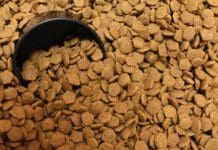Home Search
allergies/feed/rss2/Rawhide%20chews%20are%20potentially%20dangerous%20because%20they%20can%20be%20a%20choking%20hazard%20or%20cause%20gastrointestinal%20obstructions%20if%20your%20dog%20manages%20to%20chew%20off%20a%20piece%20that%20is%20small%20enough%20to%20swallow,%20but%20too%20large%20to%20pass%20unimpeded.%20In%20addition,%20some%20rawhide%20chews%20are%20hard%20enough%20to%20break%20or%20damage%20teeth. - search results
If you're not happy with the results, please do another search
Toxins That Can Arise in Dry Dog Food
For those of you just coming on board: In the July 2000 issue, we published an article called Hidden Killer in Dog Food." The article was inspired by a "case history" we received from a reader who had been through a harrowing experience with her dog. It took the reader several months and a small fortune to determine that the sudden onset of very strange and serious neurological problems with her dog was caused by a naturally occurring toxin in her dog's food. As we stated in that article
Clicker Training and Trick Training Your Dog
one
can shape a new trick."
can shape a new trick."
Much Ado About Muzzles
Let’s be clear about one thing right from the start. A muzzle won’t train your dog. It will not teach your dog to stop biting or chewing, nor will it teach him to love small children, tall men with beards, hats and umbrellas, or your veterinarian. A muzzle is a behavior management tool, properly used as a temporary measure to protect humans (or other dogs) when dogs have to be handled in situations that are too stressful for them to tolerate. A muzzle is also a flashing neon warning sign that it’s time to do some serious counter-conditioning and desensitization so the dog in question can be handled in normal situations without resorting to muzzling.
Training Foster Dogs to Walk Properly On-Leash
My husband and I acquired two (temporary) canine foundlings last week. Julie is a five-month-old purebred Akita puppy that we rescued from our local shelter, where her cage card identified her as a Shepherd/Husky mix. Her prospects for adoption were dismal, given that the shelter euthanizes 85-90 percent of incoming animals. Our second castaway, Princess, is a three-year-old Beagle mix. My husband and I were driving down a busy highway when we spotted her, hunched in the middle of the road, defecating while cars swerved around her on both sides. Princess was wearing a collar and tag, but her owners had moved, and she ended up staying at our house for several days while we tracked down their new phone number and location.
When Your Well-Trained Dog Turns Aggressive – Act Fast!
I first met Lucy at my local monthly “My Dog Can Do That” competition in January of 1998, at the SPCA in Monterey, California. She was easy to spot – a merle Great Dane with lovely natural ears, who literally towered above the competition. Lucy was attentive, responsive, performed even the most advanced MDCDT behaviors with ease, and consistently placed in the ribbons. It surprised me, then, when a few months later I heard Lucy had started threatening humans, and her aggression was escalating. This was not appropriate behavior for any dog, but particularly disturbing in one of Lucy’s size, with her potential for causing serious harm.
Canned Dog Food or Dry Dog Food? We’ll Help Break it Down
Caring guardians of companion canines often wonder whether one form of commercially prepared food – kibble or canned – is better than the other. The truth is, both types of food have relative advantages and disadvantages in terms of palatability, digestibility, and necessity for preservatives or other chemical additives. While they generally meet the same chemical composition standards in terms of vitamins, minerals, and amino acids, these types of food provide very different nutritional value.
Canine Diabetes, A Common Yet Serious Problem
Diabetes is a common and serious problem in pets. Formally known as diabetes mellitus (the sweet sickness), it’s a disorder of the pancreas gland. The pancreas produces a hormone called insulin, whose purpose is to drive nutrients, specifically glucose, or blood sugar, into the cells. It’s the body’s most important fuel molecule. Good management is the key to longevity for diabetic dogs.
Dog Stung By A Bee? Here’s How to Treat It
Hives, wheals, and welts are a moderate reaction to stings. Just like their human counterparts, dogs who have been stung can break out in unsightly hives. These are usually very itchy and uncomfortable. The first sign often noticed is the dog rubbing along furniture or scratching at the face and eyes. The hives may manifest as bright red streaks or lumps all over the body or be confined to a single place.
What is Mange in Dogs?
There may be no other canine malady that seems to inspire as much misinformation as canine mange." Internet searches often return pages that blame it on lice (wrong) as often as mites (right). Ask an older person about it and he may tell you to use a dangerous and ineffective treatment such as dousing the poor dog in used motor oil (a great way to sicken or even kill the dog). But the condition isn't a mystery
Suspect Your Itchy Dog Has a Food Allergy?
If you suspect your dog has a food allergy, follow these steps:
Treating Your Dog’s Corns and Warts
Corns and plantar warts may be common on human feet, but they’re rare in dogs – unless the dog is a Greyhound. This breed is prone to corns. Corns are keratin calluses on the front center paw pads, such as under the second toe bone, which lacks subcutaneous tissue or padding. A common treatment for corns is their removal with a small curette or scalpel, followed by smoothing with a pumice stone and the application of salicylic acid pads or ointments. Roberta Mikkelsen of Pearl River, New York, hoped that hulling (surgical removal) would help her Greyhound, Chip, recover from his painful corns. “This is such a common problem in the breed,” she says, “that there is an online forum where people list the things that did or didn’t help. So far there isn’t a cure.” After Chip’s corn was removed, it grew back.
A Canine Allergy Glossary
An Allergen is defined as a substance that causes an allergic reaction. Anything can be an allergen to a hypersensitive individual, even water. The term has meaning only in relation to an individual who is hypersensitive to that substance.











